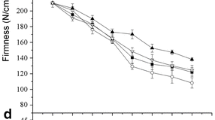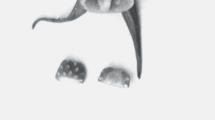Abstract
The aim of this study was to determine the effects of the synthetic auxin 3,5,6-trichloro-2-pirydiloxyacetic acid (3,5,6-TPA) on photosynthetic activity, photosynthate transport to the fruit, and fruitlet abscission to further explain the physiological basis of auxin-mediated citrus fruit thinning. Applying 15 mg l−1 3,5,6-TPA to trees during the fruit cell division stage significantly increased fruitlet abscission of Clementine mandarin. On treated trees, abnormal foliar development and photosynthetic damage were observed at the same time as 3,5,6-TPA reduced fruitlet growth rate. Briefly, treatment reduced chlorophyll and carotenoid concentrations and modified chlorophyll a fluorescence parameters, that is, reduced the quantum yield (ФPSII) of the noncyclic electron transport rate, diminished the capacity to reduce the quinone pool (photochemical quenching; qp), and increased nonphotochemical quenching (q N), thereby preventing the dissipation of excess excitation energy. In addition, the net photosynthetic flux (μmol CO2 m−2 s−1) and leaf photosynthate content decreased in treated trees. As a result, the 3,5,6-TPA treatment significantly reduced the photosynthate accumulation in fruit from day 3 to day 8 after treatment, thus reducing fruitlet growth rate. Hence, treated fruitlets significantly increased ethylene production and abscised. Twenty days after treatment, chlorophyll a fluorescence parameters and fruitlet growth rate were reestablished. Accordingly, the thinning effect of 3,5,6-TPA may be due to a temporarily induced photosynthetic disorder that leads to reduction in photosynthate production and fruitlet uptake that temporarily slows its growth, triggering ethylene production and fruitlet abscission. Afterward, the remaining treated fruit overcame this effect, increased growth rate, and reached a larger size than control fruit.






Similar content being viewed by others
References
Agustí M, El-Otmani M, Aznar M, Juan M, Almela V (1995) Effect of 3,5,6-trichloro-2-pirydiloxyacetic acid on clementine early fruitlet development and on fruit size at maturity. J Hortic Sci 70:955–962
Agustí M, Zaragoza S, Iglesias DJ, Almela V, Primo-Millo E, Talón M (2002) The synthetic auxin 3,5,6-TPA stimulates carbohydrate accumulation and growth in citrus fruit. Plant Growth Regul 36:141–147
Agustí M, Juan M, Almela V (2007) Response of ‘Clausellina’ Satsuma mandarin to 3,5,6-trichloro-2-pirydiloxyacetic acid and fruitlet abscission. Plant Growth Regul 53:129–135
Aloni R (2010) The induction of vascular tissues by auxin. In: Davies PJ (ed) Plant hormones. Biosynthesis, signal transduction, action!. Springer, Amsterdam, pp 485–506
Aznar M, Almela V, Juan M, El-Otmani M, Agustí M (1995) Effect of the synthetic auxin phenothiol on fruit development of ‘Fortune’ mandarin. J Hort Sci 70:617–621
Bangerth F (2000) Abscission and thinning of young fruit and their regulation by plant hormones and bioregulators. Plant Growth Regul 31:43–59
Bilger W, Björkman O (1991) Temperature dependence of violaxanthin de-epoxidation and non-photochemical fluorescence quenching in intact leaves of Gossypium hirsutum L. and Malva parviflora L. Planta 184:226–234
Calatayud A, Iglesias DJ, Talón M, Barreno E (2004) Response of spinach leaves (Spinacia oleracea L.) to ozone measured by gas exchange, chlorophyll a fluorescence, antioxidant systems, and lipid peroxidation. Photosynthetica 42:23–29
Calatayud A, Iglesias DJ, Talón M, Barreno E (2006) Effects of long-term ozone exposure on citrus: chlorophyll a fluorescence and gas exchange. Photosynthetica 44:548–554
Davies BH (1976) Carotenoids. In: Goodwin TW (ed) Chemistry and biochemistry of plant pigments. Academic Press, New York, pp 38–165
Demming-Adams B, Adams WW III (1996) The role of xanthophyll cycle carotenoids in the protection of photosynthesis. Trends Plant Sci 1:21–26
El-Otmani M, Coggins CW Jr, Agustí M, Lovatt CJ (2000) Plant growth regulators in Citriculture: World current uses. Crit Rev Plant Sci 19:395–447
Genty B, Briantais JM, Baker NR (1989) The relationship between the quantum yield of photosynthetic electron transport and quenching of chlorophyll fluorescence. Biochim Biophys Acta 990:87–92
Goldschmidt EE, Monselise SP (1977) Physiological assumptions toward the development of a Citrus fruiting model. Proc Int Soc Citriculture 2:668–672
Gómez-Cadenas A, Mehouachi J, Tadeo FR, Primo-Millo E, Talon M (2000) Hormonal regulation of fruitlet abscission induced by carbohydrate shortage in citrus. Planta 210:636–643
Iglesias D, Lliso I, Tadeo FR, Talón M (2002) Regulation of photosynthesis through source: sink imbalance in citrus is mediated by carbohydrate content in leaves. Physiol Plant 116:563–572
Iglesias DJ, Tadeo FR, Primo-Millo E, Talon M (2006) Carbohydrate and ethylene levels regulate citrus fruitlet drop through the abscission zone A during early development. Trees 20:348–355
Iwahori S, Oohata JT (1976) Chemical thinning of ‘Satsuma’ mandarin (Citrus unshiu Marc.) fruit by 1 naphthalene acetic acid: role of ethylene and cellulase. Sci Hortic Amsterdam 4:167–174
Martínez-Fuentes A, Mesejo C, Reig C, Agustí M (2010) Timing of the inhibitory effect of fruit on return bloom of ‘Valencia’ sweet orange (Citrus sinensis (L.) Osbeck). J Sci Food Agric 90:1936–1943
Mauk CS, Bausher MG, Yelenosky G (1986) Influence of growth regulator treatments on dry matter production, fruit abscission, and 14C-assimilate partitioning in Citrus. J Plant Growth Regul 5:111–120
Meir S, Hunter DA, Chen JC, Halaly V, Reid MS (2006) Molecular changes occurring during acquisition of abscission competence following auxin depletion in Mirabilis jalapa. Plant Physiol 141:1604–1616
Mesejo C, Martínez-Fuentes A, Juan M, Almela V, Agustí M (2003) Vascular tissues development of citrus fruit peduncle is promoted by synthetic auxins. Plant Growth Regul 39:131–135
Okuda H, Hirabayashi T (1998) Effect of IAA gradient between the peduncle and branch on physiological drop of citrus fruit (Kiyomi tangor). J Hortic Sci Biotechnol 73:618–621
Paterson SE (2001) Cutting loose. Abscission and dehiscence in Arabidopsis. Plant Physiol 126:494–500
Rivas F, Erner Y, Alós E, Juan M, Almela V, Agustí M (2006) Girdling increases carbohydrate availability and fruit-set in citrus cultivars irrespective of parthenocarpic ability. J Hortic Sci Biotechnol 81:289–295
Rivas F, Gravina A, Agustí M (2007) Girdling effects on fruit set and quantum yield efficiency of PSII in two Citrus cultivars. Tree Physiol 27:527–535
Rodrigo MJ, Marcos JF, Alférez F, Mallent MD, Zacarías L (2003) Characterization of Pinalate, a novel Citrus sinensis mutant with a fruit-specific alteration that results in yellow pigmentation and decreased ABA content. J Exp Bot 54:727–738
Romero-Puertas MC, McCarthy I, Gómez M, Sandalio LM, Corpas FJ, Del Río LA, Palma JM (2004) Reactive oxygen species-mediated enzymatic systems involved in the oxidative action of 2,4-dichlorophenoxyacetic acid. Plant Cell Environ 27:1135–1148
Schreiber U, Schliwa U, Bilger W (1986) Continuous recording of photochemical and non-photochemical fluorescence quenching with a new type of modulation fluorometer. Photosynth Res 10:51–62
Untiedt R, Blanke M (2001) Effects of fruit thinning agents on apple tree canopy photosynthesis and dark respiration. Plant Growth Regul 35:1–9
Van Doorn WG, Stead AD (1997) Abscission of flowers and floral parts. J Exp Bot 48:821–837
Acknowledgments
We thank Dr. Ángeles Calatayud from IVIA (Moncada, Spain) for technical assistance, Dr. Debra Westall (Universitat Politècnica de València, Spain) for editing the manuscript, and Mr. Vicent Martínez for technical help.
Author information
Authors and Affiliations
Corresponding author
Rights and permissions
About this article
Cite this article
Mesejo, C., Rosito, S., Reig, C. et al. Synthetic Auxin 3,5,6-TPA Provokes Citrus clementina (Hort. ex Tan) Fruitlet Abscission by Reducing Photosynthate Availability. J Plant Growth Regul 31, 186–194 (2012). https://doi.org/10.1007/s00344-011-9230-z
Received:
Accepted:
Published:
Issue Date:
DOI: https://doi.org/10.1007/s00344-011-9230-z




